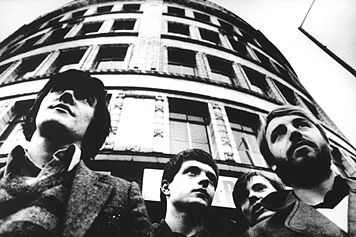Obsessions and Lamentations #3
By Alan Shulman


1) The Hills

The latest drek to be evacuated onto the collective head of the American public is this quasi-reality, quasi-soap series starring all of the usual beautiful people. In case you missed it, The Hills is the ultimate post-modern “fuck you” to the far from innocent viewing public. A show that so totally blurs the line between supposed reality and tepid melodrama can only be saying one thing – absolutely nothing matters. Is (insert ‘doll-like 20 year old female whose features have been unblemished by the vicissitudes of real life’ here) crying because (insert ‘sorta hunky guy who played soccer in high school and got laid so much he figured he could parlay it into in acting career’ here) left her? Well don’t worry, it’s not real. Not only is it not real, it’s not even fake! Don’t bother letting yourself be carried away with the skillful artifice of actual drama, because these kids aren’t really acting. And so the tendency of the American public to slowly deaden all of its emotions is reinforced, applauded, hell, almost parodied by this lifeless moneymaker. Y’know, irony is a wonderful thing, when wielded for a worthy purpose. But when it’s worn like a burka to keep the harsh light of day from touching bare flesh, then it becomes a deadly weapon, turned on ourselves.
For a lesson in how to avoid this we now turn to…
2) Joy Division

Transmission, Live performance for the BBC, available on the new Joy Division documentary from director Grant Gee.
A tall, gaunt young man stands at the microphone, looking a little uncomfortable, not only to be onstage, but in his own skin. Slowly, the song builds to a crescendo, the man begins to twitch and writhe, his eyes roll back in his head. “Dance, dance, dance, to the radio!”, and an expression of infinite sadness infects his face, as if it had been painted by a renaissance artist depicting a tormented man in Dante’s Inferno. All the pain in the world is on that face and even if you don’t know the man’s story, you know he’s not going to make it. And you realize that the young singer knows it most of all, and this realization makes the film almost too difficult to watch. But you keep staring, because it feels like he may not even make it to the end of the song, and very little attracts us as much as the end.
What set Ian Curtis and Joy Division apart from the whole moping, emo subculture spawned in its wake was the lack of a role model. The band’s sound was so unique and Curtis’ suffering so real, that their performance was never a pose, aping some gloomy archetype like the one they themselves became. Everything about them was different; the eschewing of strumming in favor of repetitive, simplistic guitar riffs; the trebly, driving bass lines; and most of all the unusual drum patterns, sounding like they were recorded in an empty tomb. On top of it all was Ian Curtis’ voice, a commanding baritone that strove for emulating the one thing he never could possess – control. It’s a sound unlike anything heard before and the band was forced to simply get on with it, rather than try to be the new Sex Pistols or Clash. Now we have a whole slew of performers pretending to feel emotions they don’t have, which, in a culture celebrating The Hills, is just as well. But this band and their two great albums endure because their desperation, the band’s to escape the confines of 70’s Manchester and Curtis’ simply to escape his debilitating epilepsy, was so real and palpable. They found a voice for it so we could feel it too, and so transcended it.
16 July, 2008 - 16:03 — Alan Shulman
